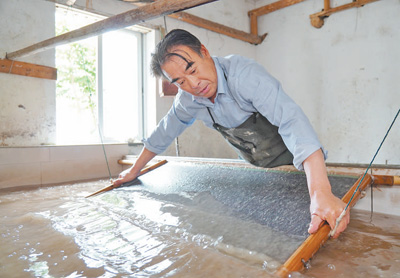Inheritor passes on traditional papermaking craft in China's Anhui

Wang Bolin makes mulberry-bark paper at his workshop in Yuexi county, Anqing city, east China's Anhui Province. (Photo/Chen Ruotian)
Born into a family engaged in papermaking for generations, Wang Bolin, 59, is the seventh-generation inheritor of the craft in his family in Yuexi county, Anqing city, east China's Anhui Province.
Wang started learning the craft of making mulberry-bark paper from his father when he was only a child. Making a sheet of mulberry-bark paper involves over 20 pure manual steps, according to Wang.
The mulberry-bark paper, known for its softness, insect resistance, high tensile strength, anti-discoloring quality, and strong water absorption, is a kind of high-quality paper used for Chinese calligraphy works and paintings, and for mounting. It's also used in packaging and making umbrellas and fans.
When making mulberry-bark paper, each step should be taken seriously, Wang said, adding that the most difficult step in making this kind of paper is the process of laozhi, which literally means getting paper out of water.
Although the process of laozhi seems simple, it takes three to five years to master the skill, Wang noted.
The craft in Yuexi faced near-extinction in the 1980s but saw a revival in 2002 when the Palace Museum started its mammoth restoration project. The museum needed specific mulberry-bark paper to restore a painting that covered an area of more than 170 square meters.
When Wang learned that the museum sought mulberry-bark paper from Anhui to restore the painting from a newspaper issued on Sept. 14, 2004, he immediately went to Beijing with the paper he made.
However, Wang's journey to provide paper for the museum wasn't smooth. His initial samples didn't meet the required standards.
Through persistent experimentation, Wang eventually produced mulberry-bark paper that met the requirements of the museum.
The craft of making handmade mulberry-bark paper was listed as a national intangible cultural heritage in 2008, and Wang became a representative inheritor of the craft.
When the Summer Palace started its restoration project in 2010, Wang received orders for mulberry-bark paper. So far, he has supplied over 600,000 sheets of mulberry-bark paper to the Palace Museum and the Summer Palace.
"It's our responsibility to preserve the craft passed down from our ancestors," Wang said, adding that his long-cherished dream is to pass the craft on to more young people.
During every summer vacation, many university students experience making mulberry-bark paper at Wang's workshop, where he teaches them in person, hoping that young people can pass on the craft.
Photos
Related Stories
- Pic story of Kaihua paper maker in China's Zhejiang
- Inheritor in E China's Anhui dedicated to passing on headdress making craft
- Pic story: inheritor of Chu-style lacquer coating craft
- Pic story: inheritor of dragon and phoenix candles making craft
- Craftsman from SW China's Yunnan turns used disposable chopsticks into wondrous miniatures of architecture
Copyright © 2024 People's Daily Online. All Rights Reserved.









